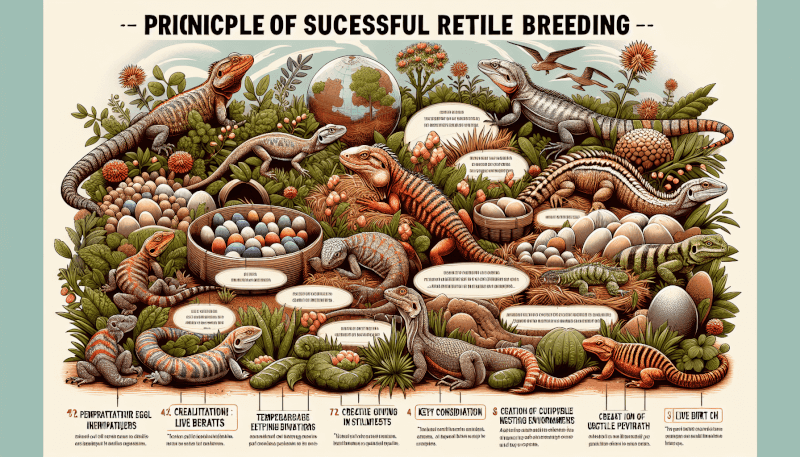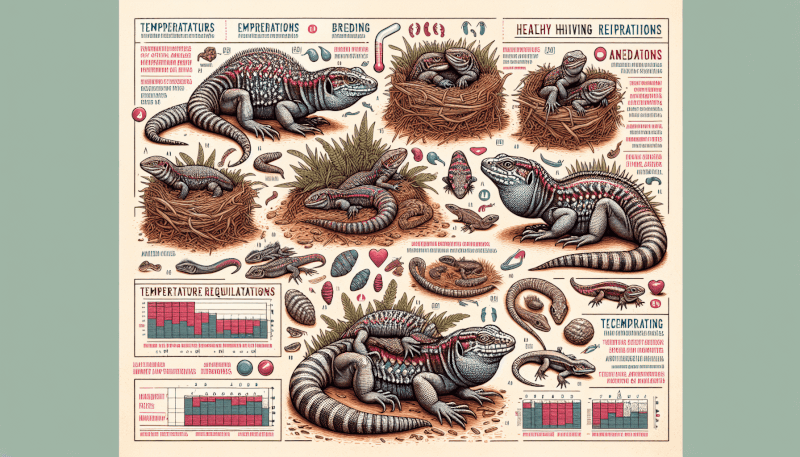Are you an aspiring reptile breeder looking for some expert advice on how to successfully breed your scaly friends? Look no further! In this article, we will provide you with valuable tips and tricks to ensure that your reptiles have the best chance of reproducing. From creating the ideal breeding environment to understanding the reproductive behavior of different reptile species, we’ve got you covered. So grab a pen and paper, because we’re about to embark on an exciting journey into the world of reptile breeding!

Housing and Environment
Choosing the Right Enclosure
When it comes to breeding reptiles, choosing the right enclosure is crucial. You want to create an environment that closely resembles their natural habitat, ensuring their comfort and well-being. Consider factors such as size, material, ventilation, and security. Adequate space allows reptiles to move around freely and exhibit natural behaviors.
Providing Adequate Space
Reptiles require ample space to thrive, especially when they are breeding. A habitat with sufficient space allows them to establish territories, court mates, and engage in mating behaviors. By providing enough room for their activities, you are supporting their physical and mental health.
Temperature and Humidity Control
Maintaining proper temperature and humidity levels in the enclosure is vital for the success of reptile breeding. Different species have specific requirements, so it’s important to research and provide a suitable thermal gradient. Additionally, providing appropriate humidity levels is crucial for egg development and hatchling health.
Proper Lighting
Proper lighting is essential for the overall health of reptiles and plays a significant role in their breeding success. Many reptiles require UVB lighting to metabolize calcium and other essential nutrients. Providing a suitable lighting system that mimics their natural day-night cycle helps regulate their biological processes and encourages breeding behavior.
Substrate Selection
Choosing the right substrate is important not just for the comfort of your reptiles, but also for their breeding success. Some substrates may be more suitable for certain species and can contribute to the overall health and hygiene of the enclosure. Consider factors such as absorptive properties, ease of cleaning, and safety when selecting a substrate for your breeding reptiles.
Feeding and Nutrition
Understanding Dietary Requirements
To ensure successful breeding, it is crucial to understand the dietary requirements of your reptiles. Different species have specific nutritional needs, including a balance of protein, vitamins, minerals, and fiber. Research the natural diet of your reptiles and provide a varied and appropriate diet that meets their specific needs.
Offering a Varied Diet
Offering a varied diet not only provides essential nutrients but also stimulates natural feeding behaviors. Include a variety of live and/or frozen prey, fruits, vegetables, and calcium and vitamin supplements in their diet. Providing a diverse range of food options enhances reproductive health and breeding success.
Supplementing with Vitamins and Minerals
Supplementing reptiles’ diet with vitamins and minerals is crucial for their overall health and reproductive performance. Calcium, in particular, is vital for egg development and preventing metabolic bone disease. Consult with a reptile veterinarian or specialist to determine the appropriate supplements for your breeding reptiles.
Feeding Frequency and Portion Sizes
Establishing a feeding schedule and appropriate portion sizes is essential for maintaining optimal health and reproductive success in breeding reptiles. Young, growing reptiles may require more frequent feeding compared to adult breeders. Ensuring that they receive the right amount of food supports successful breeding and avoids over or underfeeding.
Avoiding Common Feeding Mistakes
Avoiding common feeding mistakes is important to prevent health issues and promote breeding success. Overfeeding can lead to obesity and reproductive problems, while underfeeding can result in malnutrition and inadequate egg production. Pay attention to portion sizes, monitor feeding behavior, and adjust the diet accordingly to avoid these pitfalls.
Sexing and Pairing
Identifying the Sex of Reptiles
Accurately sexing reptiles is crucial when it comes to successful breeding. Techniques for identifying the sex of reptiles vary by species and can include visual observation, probing, or using specialized equipment. Familiarize yourself with the specific methods for your chosen species and seek advice from experienced reptile breeders or herpetologists if needed.
Age Considerations
The age of your reptiles is an important factor to consider when it comes to breeding. Some species reach sexual maturity at a young age, while others may take several years. It’s important to allow your reptiles to reach their proper reproductive age before attempting to breed them. Breeding too early can result in unsuccessful reproduction or even harm to the individuals involved.
Pairing Compatible Individuals
Pairing compatible individuals is key to successful breeding and the production of healthy offspring. Consider factors such as size, temperament, and genetic compatibility when selecting breeding pairs. Ensuring that the individuals have similar requirements and can coexist peacefully increases the chances of successful reproduction.
Avoiding Inbreeding
Inbreeding can lead to genetic disorders and weakened immune systems in reptiles. To prevent these issues, it is crucial to avoid breeding individuals that are closely related. Maintain clear records of the lineage and genetic backgrounds of your reptiles to make informed breeding decisions and minimize the potential negative effects of inbreeding.
Monitoring Mating Behavior
Observing and monitoring the mating behavior of your reptiles is essential to ensure successful reproduction. Different species exhibit various courtship and mating behaviors. Familiarize yourself with the behaviors specific to your chosen species to recognize when breeding is occurring and to provide the necessary conditions and support for successful egg-laying.
Reproduction and Nesting
Understanding Reproductive Cycles
Understanding the reproductive cycles of your reptiles is integral to successful breeding. Different species have unique breeding seasons and reproductive patterns. Research and learn about the specific reproductive cycles for your chosen species, including the timing of mating, egg-laying, and incubation periods.
Inducing Breeding Conditions
In some cases, you may need to create or manipulate breeding conditions to encourage successful reproduction in your reptiles. This can involve adjusting temperature, humidity, lighting, and other environmental factors. Consult reputable sources, such as scientific studies or experienced reptile breeders, to learn about effective methods for inducing breeding conditions in your chosen species.
Creating a Suitable Nesting Area
Providing a suitable nesting area is crucial for reptiles that lay eggs. This can involve providing appropriate substrate, such as sand or moss, to mimic their natural nesting environment. Additionally, ensuring adequate privacy and security within the nesting area can help promote successful egg-laying behavior.
Monitoring Egg Laying
Monitoring egg-laying behavior is important to ensure the health and safety of the eggs. Keep a close eye on your breeding reptiles for signs of impending egg-laying, such as restlessness or digging behavior. Provide a nesting box or suitable location for egg deposition and regularly check for the presence of eggs to ensure they are promptly attended to.
Incubation and Hatching
Once the eggs have been laid, proper incubation is vital for their development and hatching. Research the specific requirements for your reptile species, such as temperature and humidity levels, and provide a dedicated incubation setup. Regularly monitor and maintain the incubation conditions to increase the chances of successful hatching.

Health and Genetics
Maintaining Optimal Health
Maintaining the optimal health of your breeding reptiles is essential for successful reproduction. Provide a clean and hygienic environment, ensure proper nutrition, and regularly monitor for signs of illness or stress. Consult with a reptile veterinarian for routine check-ups and advice on maintaining optimal health within your breeding colony.
Regular Check-ups and Veterinary Care
Routine check-ups and veterinary care are crucial for the well-being of breeding reptiles. Schedule regular visits with a reptile veterinarian to monitor the health of your reptiles, address any potential issues, and receive guidance on breeding-related concerns. Maintaining a close relationship with a knowledgeable reptile veterinarian ensures the overall health and breeding success of your reptiles.
Genetic Considerations
Understanding the genetic background and potential risks of your breeding reptiles is important to avoid inherited disorders and promote healthy offspring. Keep detailed records of the lineage and genetic history of your reptiles to make informed breeding decisions. Breeding reptiles with diverse genetic backgrounds can help reduce the likelihood of genetic issues in their offspring.
Preventing and Managing Diseases
Preventing and managing diseases is crucial in any breeding program. Implement biosecurity measures, such as quarantine procedures and regular cleaning, to minimize the risk of disease transmission. Educate yourself on common reptile diseases and their prevention, and promptly seek veterinary care if any health issues arise within your breeding colony.
Avoiding Inherited Disorders
Avoiding the breeding of individuals with known inherited disorders is vital in maintaining the health and well-being of your reptiles. Thoroughly research the potential genetic risks associated with your chosen species and work to eliminate these disorders from your breeding program. Partnering with experienced breeders, consulting genetic experts, and participating in genetic testing can help mitigate these risks.
Breeding Season Preparation
Researching Species-specific Requirements
Before the breeding season begins, thorough research on your chosen species’ specific requirements is essential. Learn about their natural habitat, mating behaviors, and environmental needs during the breeding season. Understanding these species-specific requirements allows you to create the ideal conditions for successful breeding.
Establishing Breeding Groups
Establishing breeding groups is an important step in preparing for the breeding season. Consider factors such as genetics, compatibility, and the desired outcome of your breeding program. Introduce compatible individuals and monitor their interactions to ensure peaceful coexistence and increase the chances of successful mating and reproduction.
Conditioning and Preparing Breeders
Conditioning and preparing your breeders before the breeding season helps ensure their optimal reproductive performance. This can involve providing a balanced diet, adjusting temperature and lighting conditions, and monitoring their general health and body condition. Creating a suitable pre-breeding regimen improves the chances of successful mating and egg production.
Creating a Breeding Schedule
Creating a breeding schedule is essential in maintaining organization and maximizing breeding success. Factor in the specific reproductive cycles of your chosen species, including mating, egg-laying, and incubation periods. A well-planned breeding schedule allows you to effectively manage breeding pairs, monitor progress, and record data for future reference.
Separating and Isolating Reptiles
Separating and isolating reptiles appropriately is necessary during the breeding season. This can involve separating breeding pairs into dedicated enclosures, removing aggressive individuals, or isolating pregnant females for nesting. Proper separation and isolation help minimize stress, prevent unwanted breeding, and facilitate better control over breeding outcomes.

Egg Handling and Incubation
Collecting and Cleaning Eggs
When collecting eggs, it is important to handle them with care to avoid damage. Gently remove the eggs from the nesting area, taking care not to rotate or shake them. Avoid excessive handling and use appropriate tools, such as spoons or tongs, if necessary. Clean the eggs if needed, using a gentle antimicrobial solution to remove any dirt or debris.
Egg Incubation Methods
There are various methods of incubating reptile eggs, each with its own advantages and considerations. Choose the appropriate method for your chosen species, whether it be an artificial incubator, natural incubation, or a combination of both. Research optimal temperature and humidity levels and maintain a stable incubation environment to maximize hatching success.
Temperature and Humidity Control
Maintaining precise temperature and humidity control is crucial for successful egg incubation. Each reptile species has specific requirements, so research and monitor the ideal levels for your eggs. Use a reliable thermometer and hygrometer to ensure accurate measurement and make necessary adjustments to maintain optimal conditions for egg development.
Monitoring Development
Regularly monitoring the development of incubating eggs allows you to identify any potential issues or abnormalities. Observe the eggs for signs of fertility, such as veins or movement, and discard any infertile or damaged eggs. Keep detailed records of development stages, such as candling or X-ray imaging, to track progress and make informed decisions during incubation.
Addressing Incubation Challenges
Incubation can present various challenges, from temperature fluctuations to mold growth. Stay vigilant and address any challenges promptly to maximize hatching success. Be prepared to adjust temperature and humidity levels, remove or treat mold growth, and seek guidance from experienced breeders or reptile specialists if needed.
Caring for Hatchlings
Providing Ideal Post-Hatch Enclosures
Once the hatchlings emerge, providing suitable post-hatch enclosures is essential for their health and well-being. Size-appropriate enclosures with proper temperature gradients, humidity levels, and hiding spots are crucial. Consider the specific requirements of your reptile species and provide a safe environment that allows the hatchlings to grow, explore, and develop naturally.
Temperature and Humidity Requirements
Maintaining appropriate temperature and humidity levels is crucial when caring for hatchlings. Research the specific requirements for your reptile species and provide thermal gradients and humidity sources within their enclosures. Accurate monitoring and adjustment of these factors help ensure proper growth, development, and overall health of the hatchlings.
Feeding Newborn Reptiles
Feeding newborn reptiles requires careful consideration of their nutritional needs and appropriate prey size. Research the specific dietary requirements for your reptile species and provide a variety of small, appropriately sized prey for them to consume. Monitor feeding behavior and adjust prey sizes as the hatchlings grow to support their nutritional needs.
Preventing Cannibalism
Cannibalism can be a concern when caring for hatchlings, especially in species known for this behavior. Minimize the risk by providing individual enclosures or carefully monitoring their interactions. Separate hatchlings that show aggression or predatory behavior towards each other to prevent injury or loss.
Assisting with Shedding
Assisting with shedding is important to ensure the healthy growth and development of hatchlings. Provide proper humidity levels and hiding spots to facilitate successful shedding. If a hatchling is having difficulty shedding, monitor closely and provide assistance if necessary. This can involve gently removing any retained shed to prevent constriction or circulation problems.

Record Keeping and Documentation
Maintaining Detailed Breeding Records
Maintaining detailed breeding records is essential for managing a successful breeding program. Keep comprehensive records of breeding pairs, mating dates, egg-laying data, incubation conditions, and hatching rates. Accurate and organized records allow you to track progress, evaluate breeding outcomes, and make informed decisions for future breeding endeavors.
Tracking Health and Growth
Tracking the health and growth of your reptiles is important for assessing their overall well-being and breeding success. Record weight, size, behavior, and any health-related observations regularly. Monitor growth rates, detect any deviations from normal development, and seek veterinary care if any health issues arise. Regular tracking allows you to make informed decisions and intervene when necessary.
Recording Breeding Pairings
Maintaining detailed records of breeding pairings is essential for tracking genetic outcomes and avoiding inbreeding. Document the specific individuals involved in each breeding pairing, including their lineage, genetic background, and any potential offspring. These records enable you to make informed decisions for future breeding efforts and manage the genetic diversity within your breeding colony.
Documenting Reproductive Success
Documenting the reproductive success of your breeding reptiles is important for evaluating the effectiveness of your breeding program. Record the number of eggs laid, hatchling rates, and any notable breeding achievements. This information helps you identify trends, assess breeding pair performance, and make adjustments to optimize future reproductive success.
Sharing Information with Others
Sharing information and experiences with other reptile enthusiasts and breeders is a beneficial practice. Participate in reputable online forums, social media groups or attend reptile breeding conferences to learn from others and share your own knowledge. Collaboration and information sharing contribute to the advancement of reptile breeding practices and mutual success within the community.
Ethics and Responsibility
Understanding the Implications of Breeding
Understanding the implications of reptile breeding is essential for responsible reptile ownership. Breeding reptiles comes with important ethical considerations, including ensuring the welfare of the animals involved, preventing unnecessary breeding, and avoiding overpopulation. Educate yourself and promote responsible breeding practices that prioritize the health and well-being of the reptiles.
Promoting Good Animal Welfare Practices
Promoting good animal welfare practices is crucial when engaging in reptile breeding. Ensure that your reptiles are provided with appropriate husbandry, nutrition, and veterinary care throughout the breeding process. Minimize stress, respect their natural behaviors, and prioritize their physical and mental well-being. Good animal welfare practices contribute to the overall health and breeding success of your reptiles.
Educating Potential Reptile Owners
As a responsible reptile breeder, it is important to educate and guide potential reptile owners. Share your knowledge and experience to help them make informed decisions about responsible reptile ownership. Provide guidance on proper husbandry, responsible breeding practices, and the commitment required to care for reptiles. Educating potential owners contributes to the welfare and longevity of reptiles as pets.
Avoiding Overbreeding
Overbreeding can have detrimental consequences for both the reptiles and the reptile community as a whole. Breeding should be done responsibly, considering factors such as genetic diversity, market demand, and the ability to provide adequate care for the resulting offspring. Avoid overbreeding by carefully planning your breeding efforts and considering the long-term welfare of the reptiles.
Ethical Considerations and Conservation
Breeding reptiles should be undertaken with ethical considerations and conservation in mind. Responsible breeding practices aim to preserve genetic diversity, minimize negative impacts on wild populations, and contribute to species conservation efforts. Support organizations and initiatives that promote ethical and sustainable reptile breeding practices, as well as habitat conservation and species protection. By breeding reptiles responsibly, you can play a role in promoting conservation and preserving these fascinating creatures for future generations.


